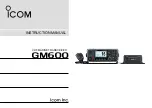
28
5
r
Access Menu 3–1 to program your call sign
(9 digits max.) {page 17}.
t
Enter a message (or bulletin) using up to 64
alphanumeric characters {page 30}.
y
If you want, access Menu 3–P (for messages) or
Menu 3–O (for bulletins) to program group codes
{page 34}.
u
Access Menu 3–C to select the operation method
for transmitting {page 25}.
The APRS
supports a function for sending a message
or bulletin independent of position reports. You can send
a message to a single station only or a bulletin to all
other stations. You may use a group code to exchange
messages among members in your group or to reject
unwanted bulletins.
Each message which you transmit can consist of up to
64 alphanumeric characters. A maximum of 16 incoming
or outgoing messages can be held in the message
memory.
OPERATION FLOW
The following steps should guide you to a good start of
APRS Message operation.
The method for transmitting differs depending on the
selection in Menu 3–C. See page 32.
When you send a message (not a bulletin), a reception
acknowledgment should be returned; “ack0 ~ 9 (or A ~ Z)”
appears. If your message is rejected by the recipient,
“rej0 ~ 9 (or A ~ Z)” appears.
Note: When using an optional VS-3 unit, you may select “APRS ONLY”
in Menu 1–2–4 (VOICE). Each time you receive a message addressed
to you, the transceiver announces the call sign of the sender. If the initial
character of the message is %, the transceiver announces the
subsequent characters one by one.
Now you are ready to receive a message from other
stations. Refer to “RECEIVING A MESSAGE” {page 29}.
To transmit a message, proceed to step
t
.
APRS
MESSAGE
q
Access Menu 3–I to select band A or B as the data
band {page 13}. The default is band A.
w
Press [F] (1 s), [TNC] to enter APRS mode.
• “TNC APRS” should appear.
e
On the data band, select the same frequency as
other stations in your group.
• You may tune to the frequency of an appropriate
digipeater network (144.390 MHz in the U.S.) {page 9}.
Summary of Contents for TM-D700A
Page 55: ......
















































